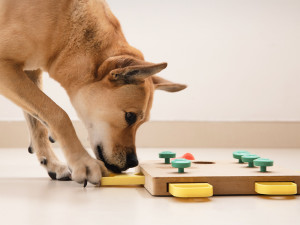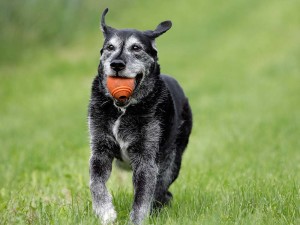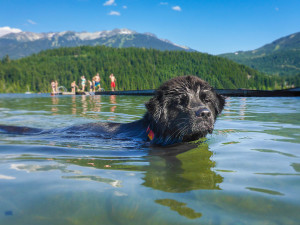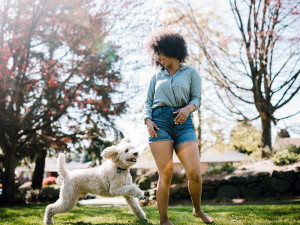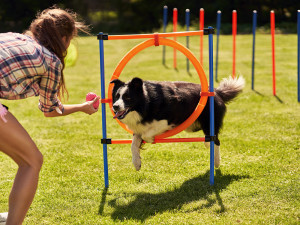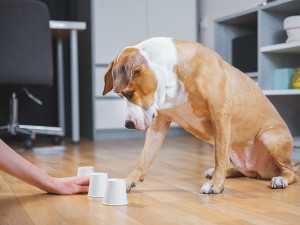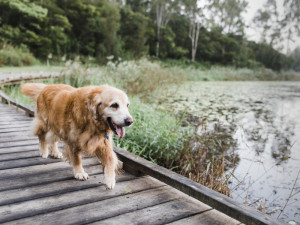How to Help Your Bored Senior Dog Spice Up Their Life
Spice Girls reference aside, just because your dog is graying around the eyes doesn’t mean those eyes don’t light up at playtime.
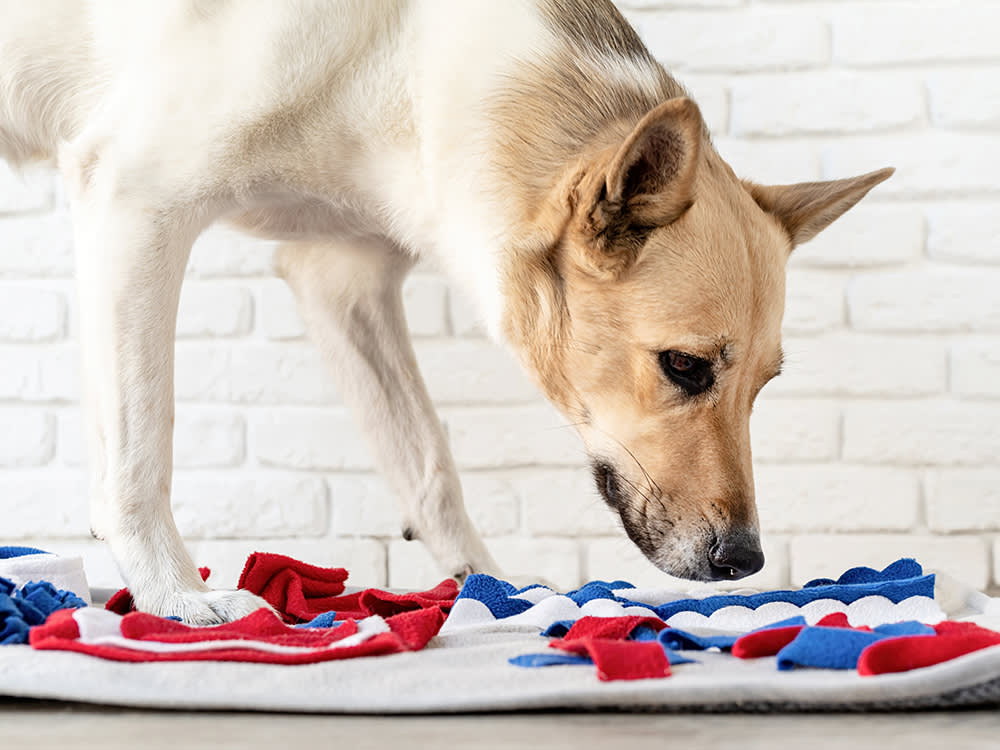
share article

Your pet wants you to read our newsletter. (Then give them a treat.)
Your senior dog’s routine is pretty simple: Wake up, go to the bathroom, run in for breakfast, find the perfect nap spot, and settle in for several hours. But even they want to mix things up a little. Contrary to the old adage, you can teach senior dogs new tricks — with adolescenceopens in a new tab out of their systems, they tend to focus pretty well on teaching moments.
“A lot of old dogs get what I call the ‘shrinking world’ syndrome,” says certified veterinary behaviorist Dr. Lore Haug. “Their owners get in a rut with them; they start walking the dog less, and they don’t train the dog or teach them tricks. The dog doesn’t get as much stimulation and enrichment — maybe they stop taking the dog to the dog parkopens in a new tab — and there’s a significant decline in mental and physical challenges.”
While we may think our older dogs are content to kick back more and interact less, in reality, the opposite is true. Their senses may not be quite as sharp as they once were, and they may not move as quickly, but having fun with their people is still a thrill. It’s also a thrill that can have a positive payback by helping them maintain their cognitive agility as they age. A little time and effort on your part will pay big and ongoing dividends in the overall quality of your dog’s life. Here are a few ideas that will provide your old pup with both physical and mental stimulation and make your dog’s senior yearsopens in a new tab the best years of their lives.
Enrichment Ideas for Senior Dogs
Keep those neurons firing and log some quality time with your dog by playing games that exercise their mind.
Rotate your dog’s toys.
Toys are one way to stimulateopens in a new tab your dog both mentally and physically. And while it’s entirely normal for a dog’s passion for toys to wane with age, there are ways to revive it, such as by rotating toys weekly because novelty inspires interest.
Try learning toys.
Interactive toys also pique curiosity. If your dog likes stuffed toysopens in a new tab, look for those with “parts” that are intended to be pulled out of or off the toyopens in a new tab. There are also toys explicitly geared toward senior dogsopens in a new tab that could be just what your dog is looking for.
Explore with nose work.
An easy way to add some change and excitement is nose workopens in a new tab. While your dog is in a sit/stay, hide a treat or toy, then release them to find it. (Cheering them on increases the excitement level.)
Teach some tricks.
Keep your senior dog’s mind healthy by teaching them a new trickopens in a new tab.
Give your pup enrichment puzzles.
Treats hidden behind panels or under sliding blocks motivate dogs to use both their noses and paws. Swedish-made Nina Ottosson puzzles opens in a new tabset the benchmark in this category.
Keep Your Senior Dog Active
An active dog is a happy dog, and that goes for senior dogs, too. Regular exercise keeps your senior dog’s joints limber and muscles strong, helps control weight, and engages the brain — all of which slow the aging process and boost your dog’s quality of life. Not only do active dogs live longer, they live better, and your bond will growopens in a new tab.
Take a walk.
The senior years can bring a golden age of walking; not only does walking get your dog moving, but the sights, smells, sounds, and tastes of the world stimulate their brainopens in a new tab. Older dogs have more trouble regulating their body temperature, so avoid exercising when it’s very hot or cold. Keep an eye on your dog for signs of fatigue or overheatingopens in a new tab.
While you want to avoid steep hills, walking up gradual hills strengthens your dog’s hindquarters. If your route includes a steep downhill, consider zigzagging your way down to avoid too much stress on your dog’s front legs. Consider bootiesopens in a new tab or paw pads with gripping treads to help your dog maintain traction on slippery surfaces.
Go for a swim.
Aerobic and low-impact, swimming is an ideal senior-dog fitness option, especially during warm months. While lakes or ponds are a fun and free option, submerged rocks or logs can make access tricky for senior dogs, and, in some cases, cold water can exacerbate arthritisopens in a new tab or joint problems.
Canine pools offer warm water swimming in a setting geared toward older or injured dogs. The warm water helps loosen joints and stimulate circulation while building muscle. Some water therapy centers have underwater treadmills, so non-swimmers can reap the benefits. In all kinds of water, a canine flotation device provides a little extra buoyancy and security for older dogs.
Do daily stretching.
If you have ever watched a dog stretch after a nap, you just know they love it. And it’s good for them. Stretching helps keep your dog feeling relaxed while promoting flexibility. You can help these natural processes with gentle guided stretchingopens in a new tab of the rear and front legs to benefit the hips, spine, knees, ankles, wrists, elbows, chest, and shoulders.
Many dog massage books or classes include stretching, or try Dogaopens in a new tab, a form of yoga that works with human-dog pairs and incorporates massage. If you cannot find a Doga class in your neighborhood, there are several good DIY guides, including Barking Buddha: Simple Soul Stretches for Yogi or Dogiopens in a new tab.
Play a game.
Behind every graying muzzle is an inner puppy itching to play. Channel that inner puppy with enriching activities that keep them strong and agile. Three dependable options that provide both physical and mental stimulation for older dogs include:
• Flatland fetch: For ball lovers with joint issues, retrieving low tosses or rolled soccer balls keeps all paws on the ground. Avoid Frisbee or a game that encourage leaping catches.
• Gentle tug-of-war: Tug at the dog’s level to keep stress off the neck.
• Agility lite: Zipping through tunnels, weaving between poles, even pausing on a floor mat (skip the table, jumps, and climbing obstacles) captures the high-thrill fun of agility without the impact.
Get Your Dog a Friend
Perhaps the ultimate enrichment strategy is to provide your old pal with a canine friend by adopting a new pup. There are lots of caveats here — among other things, not all dogs want to deal with a new dog in their homeopens in a new tab. But when it works, it works splendidly.
If you think your dog might like company, try fostering — ideally, a somewhat younger dog with a compatible personality. Some behaviorists suggest that the best age difference is around three years, while others say there are benefits to a larger spread; the older dog will teach the younger important social skills and appropriate behavior, and the younger dog will keep their elder busy and engaged.
For all dogs do to enrich our lives, we owe it to them to make sure their senior years are as enriching and fulfilling as the preceding years have been — and then some.
Susan Tasaki
Freelance writer Susan Tasaki lives in the San Francisco Bay Area with her Husky, who wishes they both got out more.
Related articles
![close up of Chihuahua dog's eye with cataracts]() opens in a new tab
opens in a new tabCommon Eye Problems in Dogs and How to Treat Them
Your dog sees you as their best friend, so keep those eyes healthy.
![Dog playing the shell game with her human. Concept of training pets, domestic dogs being smart and educated]() opens in a new tab
opens in a new tab4 Ways to Keep Your Dog Busy When They Can’t Exercise
Even if your dog is injured and can't exercise, you can still keep them entertained. Here's how.
![]() opens in a new tab
opens in a new tab13 Products Your Senior Dog Needs
From doggy diapers to toe grips, this gear will help your pet thrive through their golden years.
![Happy golden retriever dog on a walk with owner in woodsy yellow and orange fall setting with leaves on the dirt trail.]() opens in a new tab
opens in a new tabHome Remedies for Dog Joint Pain Relief
DIY ways to help your pup cope with the pain.
